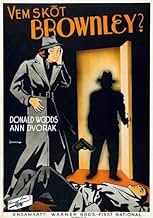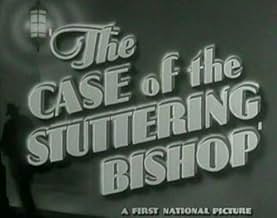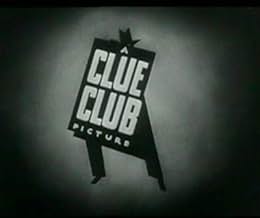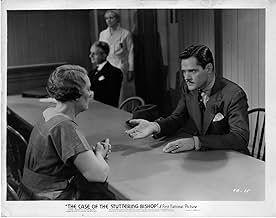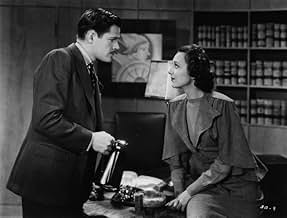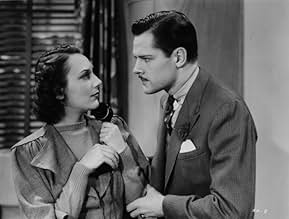An improbable stuttering bishop from Australia asks for Perry Mason's help in proving the identity of the legitimate heir to a millionaire.An improbable stuttering bishop from Australia asks for Perry Mason's help in proving the identity of the legitimate heir to a millionaire.An improbable stuttering bishop from Australia asks for Perry Mason's help in proving the identity of the legitimate heir to a millionaire.
- Director
- Writers
- Stars
Helen MacKellar
- Stella Kenwood
- (as Helen McKellar)
Charles C. Wilson
- Hamilton Burger
- (as Charles Wilson)
Eddy Chandler
- Detective James Fleet
- (uncredited)
- Director
- Writers
- All cast & crew
- Production, box office & more at IMDbPro
Featured reviews
Donald Woods stars as Perry Mason in "The Case of the Stuttering Bishop," a 1937 film that also stars Ann Dvorak as a lively Della Street. Frank Faylen is also on hand to pep things up a bit. Both of them are needed, because Donald Woods isn't terribly exciting. Of the men who played Perry Mason in the films, he is perhaps the closest rendering to the actual character. But the book Perry Mason was just that - for books - and it would take Gardner himself to not only choose Raymond Burr (the original Perry Mason was supposed to be Fred MacMurray until Gardner saw Mason at an audition for Hamilton Burger) but oversee the scripts to make the translation to the moving image.
The story concerns a mysterious bishop who asks Perry to help clear a woman accused of manslaughter many years earlier. From there, the story gets into mistaken identity - is a woman posing as an heiress or isn't she - and the solving of a murder. It's a very complicated plot, so pay attention. And Paul Drake is old. If you can sort it all out, you'll find it interesting. There's a little comedy to be had, which is helpful.
I like watching the Perry Mason movies, if only to see the different interpretations of the various roles and the emphasis put into the stories, but in the end, it's best to forget who these characters are supposed to be - because after watching the TV show for years, none of them are. So don't expect much in that department, and you won't be disappointed.
The story concerns a mysterious bishop who asks Perry to help clear a woman accused of manslaughter many years earlier. From there, the story gets into mistaken identity - is a woman posing as an heiress or isn't she - and the solving of a murder. It's a very complicated plot, so pay attention. And Paul Drake is old. If you can sort it all out, you'll find it interesting. There's a little comedy to be had, which is helpful.
I like watching the Perry Mason movies, if only to see the different interpretations of the various roles and the emphasis put into the stories, but in the end, it's best to forget who these characters are supposed to be - because after watching the TV show for years, none of them are. So don't expect much in that department, and you won't be disappointed.
The Perry Mason series of mysteries from the 1930s are some of the best mysteries one could watch. One needs to pay attention to details throughout the film to follow the twists in the plot, which in this movie is very complicated. The movies closely follow the Erle Stanley Gardner mystery novels on which they are based. The Case of the Stuttering Bishop holds one's interest from beginning to end as Perry Mason cleverly addresses the case of a murder committed over a will, inheritance and the fraudulent identity of a key player. Donald Woods does not play the role of Perry Mason as well as Warren William did in this series. William plays the role with panache and wit, whereas Donald Woods plays the role straightforward with no flair—serviceable but not exciting. Ann Dvorak plays the role of Della Street straightforward also with none of the sassiness and cuteness of Genevieve Tobin and none of the glamour and screen presence of Helen Trehnolme in other movies in the series. If you are a fan of old, intriguing mysteries, you won't be disappointed with this gem.
As someone who has read all 82 of the Perry Mason novels, I have to say that this is the best I've seen of the Warner Brothers Perry Mason films. Readers of Gardner's mysteries will appreciate how faithfully the screen writers were able to keep to the essentials of the original plot in this short 70 minute film.
This film is far superior to the turkeys WB made with Warren William (although that's not saying much.) And Donald Woods was more like the literary Mason than Raymond Burr, who was almost fat enough by the end of the TV series to play Nero Wolfe!
And, of course, there's the great 1930's atmosphere in this film, something the TV series could never hope to reproduce.
This film is far superior to the turkeys WB made with Warren William (although that's not saying much.) And Donald Woods was more like the literary Mason than Raymond Burr, who was almost fat enough by the end of the TV series to play Nero Wolfe!
And, of course, there's the great 1930's atmosphere in this film, something the TV series could never hope to reproduce.
Most of Edward McWade's roles were uncredited, but he certainly paid his dues in film-making; he had been making movies since 1919. Here he plays the stuttering bishop, who shows up at the office of Perry Mason (Donald Woods this time... Warren William had been playing Perry Mason for most of the 1930s.) with a case, then disappears. He makes accusations against the local rich man, Renald Brownley, played by Douglas Wood. Anne Dvorak and Joseph Crehan in supporting roles, as Mason confronts Brownley and tries to sort out the clues and what's going on. People start turning up dead, people are fighting, and then we're in the courtroom, like any good episode of Perry Mason. There are some comical moments, mostly between Mason and Della Street, and the names are a little confusing, with a Della, a Stella, TWO girls named Janice, and even an Ida. It's solid enough, with the usual court-room drama and outbursts. Directed by William Clemens, who had also directed many of the Nancy Drew and The Falcon films.
We had two great evolutionary paths in the 30s. One was an amazing diversity of invention to settle some basic narrative devices that have since served us well as the basic vocabulary of cinema. The other, parallel path was the pulp detective novel, a master of which was Gardner.
The traditional, Holmes form is that you are linked to the detective. You discover what he does. Christie followed this form, but it is difficult to render in film. Gardner may be the first case — since common — of the novel adopting cinematic form. His formula does seem friendly to film: we see events that Mason does not, often before he gets seriously engaged. These events give us a false impression of what happened, so we as viewers start out with a deficit.
Then we have the detection; Mason and company are detectives in act two. The third act is always a courtroom, which is why our detective has to be a lawyer. Courtroom conventions have their own evolution in film, and this instance is limited to what in Christie's stories has to be a contrived assembly of the suspects.
This format allows for more complicated mysteries than were usual in film. My own preference for 30's detection is Philo Vance because the formula was not so strict. But this is a good one in terms of allowing complexity and surprise. We have that here in this solid instance.
One of the decisions in defining the characters is how intimate to make the relationship between alpha male Mason and his pretty and competent secretary. Why this matters has to do, as Mason would say, with motive. We like the guy. He is smart, as smart as other detectives, but why he does what he does
In some renderings of the Mason format, he just likes to win. He has his own Lestrade who he likes humiliating. Justice is incidental, and truth merely a tactic. He just like to strut.
In other renderings, he does what he does because he loves his team, his closest friend Drake and his lover Della. Both are profoundly loyal and true. He struts for her and we imagine passion after the obligatory Italian restaurant scene.
Here, a delicate balance between the two is maintained.
The traditional, Holmes form is that you are linked to the detective. You discover what he does. Christie followed this form, but it is difficult to render in film. Gardner may be the first case — since common — of the novel adopting cinematic form. His formula does seem friendly to film: we see events that Mason does not, often before he gets seriously engaged. These events give us a false impression of what happened, so we as viewers start out with a deficit.
Then we have the detection; Mason and company are detectives in act two. The third act is always a courtroom, which is why our detective has to be a lawyer. Courtroom conventions have their own evolution in film, and this instance is limited to what in Christie's stories has to be a contrived assembly of the suspects.
This format allows for more complicated mysteries than were usual in film. My own preference for 30's detection is Philo Vance because the formula was not so strict. But this is a good one in terms of allowing complexity and surprise. We have that here in this solid instance.
One of the decisions in defining the characters is how intimate to make the relationship between alpha male Mason and his pretty and competent secretary. Why this matters has to do, as Mason would say, with motive. We like the guy. He is smart, as smart as other detectives, but why he does what he does
In some renderings of the Mason format, he just likes to win. He has his own Lestrade who he likes humiliating. Justice is incidental, and truth merely a tactic. He just like to strut.
In other renderings, he does what he does because he loves his team, his closest friend Drake and his lover Della. Both are profoundly loyal and true. He struts for her and we imagine passion after the obligatory Italian restaurant scene.
Here, a delicate balance between the two is maintained.
Did you know
- TriviaAuthor Erle Stanley Gardner objected so vehemently to what he felt was the miscasting of Ricardo Cortez as Mason, that Warners replaced him with Donald Woods.
- GoofsNear the end, when Mason and his crew are having lunch during a court recess, Della drops her fork on her plate and reaches out across the table to break off some bread (after giving Mason the inadvertent hunch about Stella Kenwood). When the camera cuts back to Mason, Della has fork in hand again, but not the bread.
- Quotes
Perry Mason: [to Della] Bishops don't often need lawyers. Show him in.
- ConnectionsFeatured in Le grand sommeil (1946)
- SoundtracksWhen Irish Eyes Are Smiling
(1912) (uncredited)
Music by Ernest Ball
Lyrics by Chauncey Olcott and George Graff
Sung a cappella with a phony Irish brogue by Donald Woods
Details
- Release date
- Country of origin
- Language
- Also known as
- Clue Club #10: The Case of the Stuttering Bishop
- Filming locations
- Production company
- See more company credits at IMDbPro
- Runtime1 hour 10 minutes
- Color
- Sound mix
- Aspect ratio
- 1.37 : 1
Contribute to this page
Suggest an edit or add missing content

Top Gap
By what name was The Case of the Stuttering Bishop (1937) officially released in India in English?
Answer
